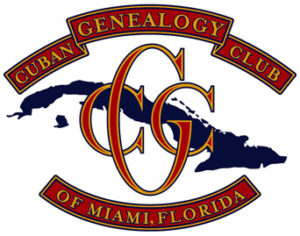Researching in Spain
About Spain
Spain is a country primarily located in southwestern Europe’s Iberian Peninsula with parts of the territory in the Atlantic Ocean and across the Mediterranean Sea. The largest part of Spain is situated on the Iberian Peninsula which includes 17 autonomous regions with diverse geography and cultures. Its territory also includes the Canary Islands in the Atlantic Ocean, the Balearic Islands in the Mediterranean Sea, and the autonomous cities of Ceuta and Melilla in Africa.
IMPORTANT: Please contact, and credit, the CGC if you use any part of this collection by sending an email to secretary@cubangenclub.org.
Languages of Spain
The majority of languages of Spain belong to the Romance language family, of which Spanish is the sole one with official status as the national language. However, a number of other languages and dialects belonging to the Romance continuum exist in Spain.
Co-official in Catalonia, the Valencian Community, and the Balearic Islands. It is also spoken in the eastern strip of the Aragon region (La Franja) and the Carche area of the Region of Murcia. In the Valencian Community and el Carche, it is known as Valencian.
It is spoken in Galicia (where it has co-official status) as well as in nearby areas of Asturias, Castile, and León.
A standardized variety of the Asturleonese dialect continuum. It enjoys protection in Asturias, where reportedly about 25% of the population is able to understand, speak, read, and write in the language. Asturleonese varieties, collectively known as Leonese, are spoken in parts of Castile and León (provinces of León and Zamora), where they enjoy legal protection.
It has been traditionally spoken by the inhabitants of the following border areas: Cedillo and Herrera de Alcántara (province of Cáceres), La Alamedilla (province of Salamanca, primarily spoken in the place up until the mid-20th century), and Olivenza (province of Badajoz.)
A mixed language, is spoken by the Spanish Romani communities across the country, with a large concentration in Andalusia and Catalonia, though it seems to be in the process of becoming just a dialect of Spanish. (It should not be confused with Romani, the Indo-Aryan language originally spoken by gypsies, which is most probably no longer spoken in Spain.)
Co-official in the Basque Country and northern Navarre. Basque is the only non-Romance language (as well as non-Indo-European) with an official status in Spain.
A standarized variety of Occitan which is co-official in Catalonia. It is spoken in comarca of the Aran Valley, near the French border.
It is spoken in the north of the Aragon region, in the Pyrenees. It enjoys legal protection.
This romance language belonging to the Galician-Portuguese group is spoken by about 6,000 people in the Jálama Valley. It has been declared Bien de interés cultural.
This is a whistled code in La Gomera (Canary Islands). Protected by UNESCO (Intangible Cultural Heritage of Humanity).
It is spoken in Ceuta. It lacks government protection.
Riffian (Tmazight or Tarifit Berber)
It is spoken in Melilla. It lacks government protection.
Finding Your Ancestor
General Information and Terminology
17 Autonomous Regions of Spain
1- The autonomous community (comunidad autónoma) is the first sub-national level of political and administrative division. There are 17 autonomous communities and two autonomous cities (Ceuta and Melilla) which are collectively known as “autonomies” or regions. The two autonomous cities have the right to become autonomous communities.
Source: https://en.wikipedia.org/wiki/Autonomous_communities_of_Spain
Map of the 17 Autonomous Communities
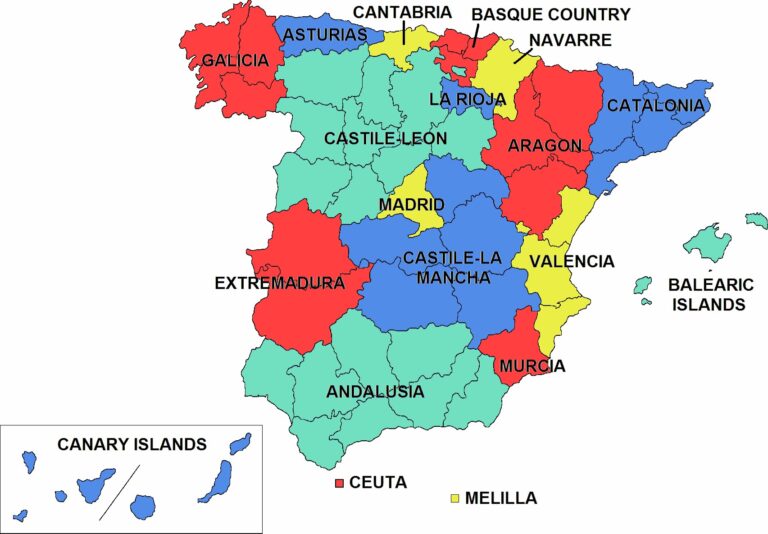
Map source: https://commons.wikimedia.org/wiki/File:Ccaa-spain.png
2- A province is a territorial division defined as a collection of municipalities. The current provinces of Spain correspond to the provinces created under the purview of the 1833 territorial re-organization of Spain. There are many other groupings of municipalities that comprise the local government of Spain. The boundaries of provinces can only be altered by the Spanish Parliament, giving rise to the common view that the 17 autonomous communities are subdivided into 50 provinces. In reality, the system is not hierarchical but defined according to jurisdiction (competencias).
3 -The municipality (Spanish: municipio, Catalan: municipi, Galician: concello, Basque: udalerria, Asturian: conceyu) is one of the two fundamental territorial divisions in Spain, the other being the provinces.
Spain is divided territorially into:
8,131 municipalities and 3,683 sub-municipal entitles each with political, administrative and are their own constituencies.
465 comarcas*, 83 of which have administrative and political functions
50 provinces, nine of which have no political or administrative function but all of which are constituencies for the national parliament.
Both provinces and comarcas are groupings of municipalities.
Sources: https://en.wikipedia.org/wiki/Provinces_of_Spain; https://en.wikipedia.org/wiki/Municipalities_of_Spain; https://en.wikipedia.org/wiki/Comarcas_of_Spain
Map of the Provinces
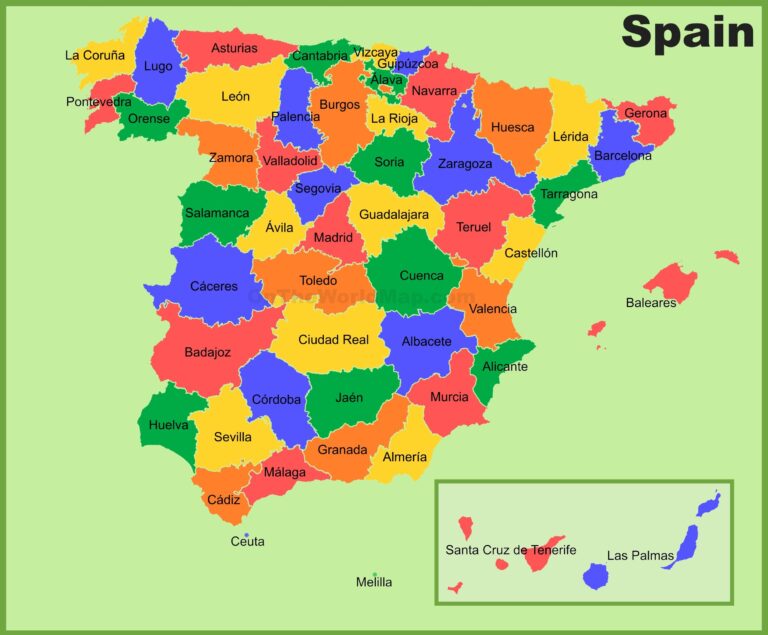
Map Source: https://ontheworldmap.com/spain/spain-provinces-map.html#google_vignette
4 – A comarca (see further below) is either a traditional territorial division without any formal basis or a group of municipalities legally defined by an autonomous community to provide standard local government services. A comarca is equivalent to a district, county, area, or zone. Most legally defined comarcas are in Catalonia (42) and Aragon (33), are regulated by law, and are governed by a comarcal council with specified powers. Seven comarcas are formally registered in Basque Country and one in Castile and León. In Andalusia and Asturias, comarcas are defined by law but lack any defined function. In other regions, comarcas are traditional or historical or, in some cases, contemporary creations designed for tourism promotions.
5 – Parishes or Parroquias:
In Asturias, a parish is a traditional administrative, religious, and agrarian organization.
In Galicia, a parish is the name that collective population entities receive, originating in ecclesiastical parishes. It is the traditional territorial division of the municipalities (concellos) and each parish includes one or several population entities.
Source: https://en.wikipedia.org/wiki/Parroquia_(Spain)
Examples
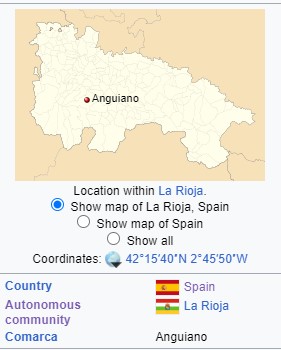
Anguiano is both a municipality and a town in La Rioja. Notice the term “comarca” instead of municipality, although it is both a municipality and town.
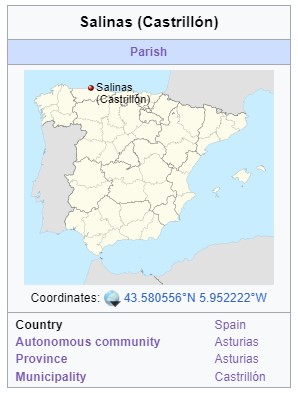
Salinas is both a parish (parroquia) and a village in the municipality of Castrillón.
Spanish Autonomous Communities,
Their Provinces and Capitals
Source: https://en.wikipedia.org/wiki/Provinces_of_Spain
Spanish Comarcas by Autonomous Communitites
In Spain, a comarca is either a traditional territorial division without any formal basis or a group of municipalities legally defined by an autonomous community to provide standard local government services. A comarca is equivalent to a district, county, area, or zone in English. The large majority of legally defined comarcas are in Catalonia (42) and Aragon (33) and are regulated by law and are governed by a comarcal council with specified powers. Seven comarcas are formally registered in Basque Country and one in Castile and León. In Andalusia and Asturias, comarcas are defined by law but lack any defined function. In other regions, comarcas are traditional or historical or, in some cases, contemporary creations designed for tourism promotions.
Both provinces and comarcas are groupings of municipalities.
Comarcas of Andalusia
Comarcas of the province of Almería
- Alto Almanzora
- Poniente Almeriense
- Comarca Metropolitana de Almería
- Los Vélez
- Los Filabres-Tabernas
- Levante Almeriense
- Alpujarra Almeriense
Comarcas of the province of Cádiz
- Bahía de Cádiz
- Bajo Guadalquivir, also called Costa Noroeste
- Campo de Gibraltar
- La Janda
- Campiña de Jerez, also called Marco de Jerez
- Sierra de Cádiz
Comarcas of the province of Córdoba
- Alto Guadalquivir
- Campiña de Baena
- Campiña Este – Guadajoz
- Campiña Sur
- Los Pedroches
- Subbetica
- Valle del Guadiato
- Valle Medio del Guadalquivir
Comarcas of the province of Granada
- Alpujarra Granadina
- Comarca de Alhama
- Comarca de Baza
- Comarca de Guadix
- Comarca de Huéscar
- Comarca de Loja
- Costa Granadina
- Los Montes
- Valle de Lecrín
- Vega de Granada
Comarcas of the province of Huelva
- Andévalo
- Condado de Niebla
- Cuenca Minera de Riotinto
- Costa Occidental de Huelva
- Metropolitana de Huelva
- Sierra de Aracena
Comarcas of the province of Jaén
- Alto Guadalquivir – Cazorla
- La Campiña
- El Condado
- Área Metropolitana de Jaén
- La Loma
- Las Villas
- Sierra Norte
- Sierra Mágina
- Sierra de Segura
- Sierra Sur de Jaén
Comarcas of the province of Málaga
- Antequera
- Axarquía(Eastern Costa del Sol)
- Costa del Sol Occidental(Western Costa del Sol)
- Guadalteba
- Málaga– Costa del Sol
- Nororiental de Málaga(“Nororma”)
- Serranía de Ronda
- Sierra de las Nieves
- Valle del Guadalhorce
Comarcas of the province of Sevilla
Comarcas of Aragon
Comarcas of the province of Huesca/Uesca
- Alto Gállego
- Bajo Cinca, also called Baix Cinca
- Cinca Medio
- Hoya de Huesca, also called Plana de Uesca
- Jacetania
- La Litera, also called La Llitera
- Monegros
- Ribagorza
- Sobrarbe
- Somontano de Barbastro
Comarcas of the province of Teruel
- Bajo Martín
- Jiloca
- Cuencas Mineras
- Andorra-Sierra de Arcos
- Bajo Aragón
- Comunidad de Teruel
- Maestrazgo
- Sierra de Albarracín Comarca, named after the Sierra de Albarracín mountain range
- Gúdar-Javalambre
- Matarraña (Matarranya in Catalan spelling)
Comarcas of the province of Zaragoza
- Aranda
- Bajo Aragón-Caspe, also called Baix Aragó-Casp
- Campo de Belchite
- Campo de Borja
- Campo de Cariñena
- Campo de Daroca
- Cinco Villas
- Comunidad de Calatayud
- Ribera Alta del Ebro
- Ribera Baja del Ebro
- Tarazona y el Moncayo
- Valdejalón
- Zaragoza
Comarcas of Asturias
Comarcas of the Balearic Islands
Mallorca
Menorca
Pitiüses
Eskualdeak / Comarcas of the Basque Country
Eskualdeak / Cuadrillas of the province of Álava-Araba
- Añana
- Aiara / Ayala
- Llanada Alavesa / Arabako Lautada
- Vitoria-Gasteiz
- Gorbeialdea
- Arabako Mendialdea / Montaña Alavesa
- Arabako Errioxa / Rioja Alavesa
Eskualdeak / Comarcas of the province of Biscay
Eskualdeak / Comarcas of the province of Gipuzkoa
- Bidasoa-Txingudi
- Debabarrena
- Debagoiena
- Goierri
- Donostialdea
- Tolosaldea
- Urola Kosta
- Urola Erdia
- Urola Garaia
Comarcas of the Canary Islands
Comarcas of the province of Las Palmas
Comarcas of the province of Tenerife
Comarcas of Cantabria
- Comarca de Santander
- Besaya
- Saja-Nansa
- Costa occidental
- Costa oriental
- Trasmiera
- Pas-Miera
- Asón-Agüera
- Liébana
- Campoo-Los Valles
Comarques of Catalonia
Comarques of the province of Barcelona
- Alt Penedès
- Anoia
- Bages
- Baix Llobregat
- Barcelonès
- Berguedà
- Garraf
- Maresme
- Moianès
- Osona
- Vallès Occidental
- Vallès Oriental
Comarques of the province of Girona
- Alt Empordà
- Baix Empordà
- Baixa Cerdanya(partly)
- Garrotxa
- Gironès
- Osona(partly)
- Pla de l’Estany
- Ripollès
- Selva
Comarques of the province of Lleida
- Alt Urgell
- Alta Ribagorça
- Baixa Cerdanya(partly)
- Garrigues
- Noguera
- Pallars Jussà
- Pallars Sobirà
- Pla d’Urgell
- Segarra
- Segrià
- Solsonès
- Urgell
- Val d’Aran
Comarques of the province of Tarragona
Comarcas of Castile–La Mancha
Comarcas of the province of Albacete
- Llanos de Albacete
- Campos de Hellín
- La Mancha del Júcar-Centro
- La Manchuela
- Monte Ibérico-Corredor de Almansa
- Sierra de Alcaraz y Campo de Montiel
- Sierra del Segura
Comarcas of the province of Ciudad Real
Comarcas of the province of Cuenca
- Alcarria conquense.
- La Mancha de Cuenca.
- Manchuela conquense.
- Serranía Alta.
- Serranía Baja.
- Serranía Media-Campichuelo.
Comarcas of the province of Guadalajara
Comarcas of the province of Toledo
- Campo de San Juan
- La Jara
- La Campana de Oropesa
- Mancha Alta de Toledo
- Mesa de Ocaña
- Montes de Toledo
- La Sagra
- Sierra de San Vicente
- Tierras de Talavera
- Torrijos (comarca)
Comarcas of Extremadura
Comarcas of the province of Badajoz
- Campiña Sur (Badajoz)
- La Serena, Spain
- La Siberia
- Las Vegas Altas
- Llanos de Olivenza
- Sierra Suroeste
- Tentudía
- Tierra de Badajoz
- Tierra de Barros
- Tierra de Mérida – Vegas Bajas
- Zafra – Río Bodión
Comarcas of the province of Cáceres
- Comarca de Cáceres
- Campo Arañuelo
- La Vera
- Las Hurdes
- Las Villuercas
- Los Ibores
- Sierra de Gata (comarca)
- Tajo-Salor
- Tierra de Alcántara
- Trasierra/Tierras de Granadilla
- Tierra de Trujillo
- Valencia de Alcántara
- Valle del Ambroz
- Valle del Jerte
- Vegas del Alagón
Comarcas of Galicia
Comarcas of the province of A Coruña
- A Barcala
- A Coruña
- Arzúa
- Barbanza
- Betanzos
- Bergantiños
- Eume
- Ferrol
- Fisterra
- Muros
- Noia
- O Sar
- Ordes
- Ortegal
- Santiago
- Terra de Melide
- Terra de Soneira
- Xallas
Comarcas of the province of Lugo
- A Fonsagrada
- A Mariña Central
- A Mariña Occidental
- A Mariña Oriental
- A Ulloa
- Chantada
- Lugo
- Meira
- Os Ancares
- Quiroga
- Sarria
- Terra Chá
- Terra de Lemos
Comarcas of the province of Ourense
- Allariz – Maceda
- A Baixa Limia
- O Carballiño
- A Limia
- Ourense
- O Ribeiro
- Terra de Caldelas
- Terra de Celanova
- Terra de Trives
- Valdeorras
- Verín
- Viana
Comarcas of the province of Pontevedra
Comarcas of Castile and León
Comarcas of the province of Ávila
- La Moraña
- Comarca de Ávila(Valle de Amblés y Sierra de Ávila)
- Comarca de El Barco de Ávila – Piedrahíta(Alto Tormes y Valle del Corneja)
- Comarca de Burgohondo – El Tiemblo – Cebreros(Valle del Alberche y Tierra de Pinares)
- Comarca de Arenas de San Pedro
Comarcas of the province of Burgos
- Merindades
- Páramos
- La Bureba
- Ebro
- Odra-Pisuerga
- Alfoz de Burgos
- Montes de Oca
- Arlanza
- Sierra de la Demanda
- Ribera del Duero
Comarcas of the province of León
- La Montaña de Luna
- La Montaña de Riaño
- La Cabrera
- Astorga
- El Bierzo
- Tierras de León
- La Bañeza
- El Páramo
- Esla-Campos
- Sahagún
Comarcas of the province of Palencia
Comarcas of the province of Salamanca
- Comarca de Vitigudino (El Abadengo, Las Arribes, Tierra de Vitigudino and La Ramajería)
- Comarca de Ciudad Rodrigo(Ciudad Rodrigo, Campo de Argañán, Campo del Yeltes, Los Agadones, Campo de Robledo and El Rebollar)
- La Armuña
- Las Villas
- Tierra de Peñaranda
- Tierra de Cantalapiedra
- Tierra de Ledesma
- Comarca de Guijuelo(Entresierras, Salvatierra and Alto Tormes)
- Tierra de Alba
- Sierra de Béjar
- Sierra de Francia
- Campo de Salamanca
Comarcas of the province of Segovia
An official classification establishes three comarcas:
or sometimes four:
- Tierra de Pinares (shares with the province of Valladolid)
- Segovia
- Sepúlveda
- Tierra de Ayllón
However, historic approaches (before the national classification into provinces) establish six comarcas:
- Tierra de Pinares
- Tierra de Ayllón
- Tierras de Cantalejo y Santa María la Real de Nieva
- Páramos del Duratón
- Tierra de Segovia
- Tierra de Sepúlveda
Comarcas of the province of Soria
- Comarca de Almazán
- Comarca de Berlanga
- Comarca de Burgo de Osma
- Comarca de Campo de Gómara
- Comarca de El Valle
- Comarca de Pinares
- Comarca de Soria
- Comarca de Tierras Altas
- Comarca del Moncayo
- Tierra de Medinaceli
Comarcas of the province of Valladolid
- Tierra de Campos
- Montes Torozos
- Páramos del Esgueva
- Tierra de Pinares
- Campo de Peñafiel
- Campiña del Pisuerga
- Tierras de Medina
Comarcas of the province of Zamora
- Alfoz de Toro
- Aliste
- Benavente y Los Valles
- La Carballeda
- La Guareña
- Sayago
- Tábara
- Tierra de Alba
- Tierra de Campos
- Tierra del Pan
- Tierra del Vino
Comarcas of La Rioja
- Rioja Alta
- Rioja Baja
- Tierra de Cameros
- Camero Nuevo (from Iregua river to West)
- Camero Viejo (from Leza river to East)
Comarcas of Madrid
- Comarca de Alcalá or Tierra de Alcalá
- La Alcarria
- Madrid
- Corredor del Henares
- Sierra Norte
- Sierra Este
- Sierra Noroeste
- Sierra Oeste
- Madrid Sur
- Las Vegas del Tajo
- Vega del Jarama
Comarcas of Region of Murcia
- Altiplano
- Alto Guadalentín
- Bajo Guadalentín
- Campo de Cartagena
- Huerta de Murcia
- Región del Mar Menor
- Región del Noroeste
- Región del Río Mula Cuenca del Río Mula)
- Región Oriental
- Valle de Ricote
- Vega Alta (Comarca de la Vega Alta del Segura)
- Vega Media (Comarca de la Vega Media del Segura)
Eskualdeak / Comarcas of Navarre
- Bortziriak / Cinco Villas
- Baztan
- Tudela
- Bidasoa Garaia / Alto Bidasoa
- Sakana / Barranca
- Aralarraldea / Norte de Aralar
- Ultzamaldea
- Agoitz / Aoiz
- Irunberri / Lumbier
- Auñamendi
- Iruñerria / Cuenca de Pamplona
- Gares / Puente la Reina
- Estella Oriental
- Estella Occidental
- Zangoza / Sangüesa
- Tafalla
- Ribera del Alto Ebro
- Ribera Arga-Aragón
- Erronkari-Zaraitzu / Roncal-Salazar
Comarques of the Valencian Community
Comarques of the province of Alicante
- Alacantí
- Alcoià
- Alt Vinalopó
- Baix Vinalopó
- Comtat
- Marina Alta
- Marina Baixa
- Vega Baja del Segura/ Baix Segura
- Vinalopó Mitjà
Comarques of the province of Castellón
Comarques of the province of Valencia
Source: https://en.wikipedia.org/wiki/Comarcas_of_Spain
Civil Registry in Spain
The first Civil Registry that operated regularly in Spain was created only for medium and large populations. It began on January 1, 1841, and was replaced by the current one after thirty years of operation.
The current Civil Registry in Spain began on January 1, 1871. This law required all municipalities to create a Civil Registry in which data referring to the civil status of all Spaniards (births, marriages, deaths, etc.) had to be registered, regardless of their beliefs.
Source: Wikipedia – https://es.wikipedia.org/wiki/Registro_Civil_(Espa%C3%B1a)
Before 1871 you need to research ecclesiastical records.
Spain Civil Registration – General Information
Civil Registries of Spain Organized Geographically
https://www.axesor.es/registro/civil
Through this Directory of Civil Records, you can carry out any procedure online: birth certificates, marriage certificates, death certificates, or any other procedure. Access any Civil Registry: Madrid, Barcelona, Seville, Valencia, Bilbao, and any other Civil Registry in Spain.
Civil Registers for:
Alava, Castellon, La Rioja, Salamanca, Albacete, Ceuta, Las Palmas Santa Cruz De Tenerife, Alicante, Ciudad Real, Leon, Segovia, Almeria, Cordoba, Lleida, Sevilla, Asturias, Cuenca, Lugo, Soria, Avila, Girona, Madrid, Tarragona, Badajoz, Granada, Malaga, Teruel, Baleares, Guadalajara, Melilla, Toledo, Barcelona, Guipuzcoa, Murcia, Valencia, Burgos, Huelva, Navarra, Valladolid, Caceres, Huesca, Orense, Vizcaya, Cadiz, Jaen, Palencia, Zamora, Cantabria, La Coruña, Pontevedra, and Zaragoza
E-mail Addresses for the Civil Registries of Spain PDF
Source: Posted to the “Informacion. Certificaciones de Nacimientos, Fe de Bautizos en España LMD” Facebook Group on April 8, 2024.
